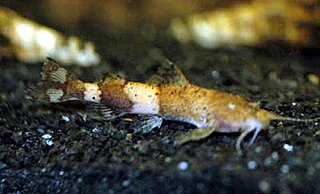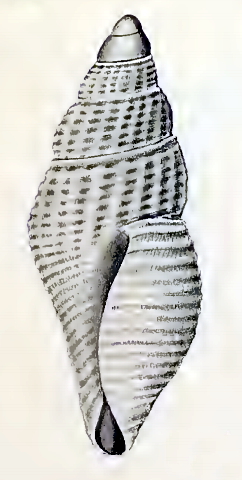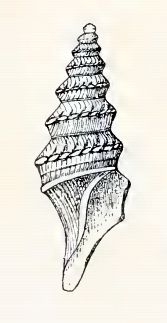
The clown loach, or tiger botia, is a tropical freshwater fish belonging to the botiid loach family. It is the sole member of the genus Chromobotia. It originates in inland waters in Indonesia on the islands of Sumatra and Borneo. In Sentarum, West Borneo that fish named: ulanguli. It is a popular fish in the freshwater aquarium trade and is sold worldwide.

The loach catfishes are a family, Amphiliidae, of catfishes. They are widespread in tropical Africa, but are most common in streams at high elevations; most species are able to cling to rocks in fast-flowing streams. The 13 genera contain 68 species.

Pseudolaguvia is a genus of South Asian river catfishes. These species inhabit hill streams and large rivers. P. tenebricosa is found in fast running, clear water; the river has a sandy bottom and numerous rocks and boulders and aquatic vegetation is absent. P. inornata is from clear, shallow, moderately flowing streams with a predominantly sandy bottom. P. muricata is found in clear, shallow, slow-flowing streams with a mixed substrate of sand and detritus; these fish are found amongst detritus in areas with current. P. ferula is also found in swift flowing waters with a mixed rocky/sandy bottom.

The Japanese roughshark is a rare species of shark in the family Oxynotidae, known only from a handful of specimens recovered from Suruga Bay and the Enshunada Sea off Japan. It is a benthic species that occurs at a depth of 150–350 m (490–1,150 ft). This shark is caught as bycatch by bottom trawlers throughout its entire limited range, and may be threatened given the declines in other bottom deep sea species in Suruga Bay.
Erethistoides is a genus of South Asian river catfishes.
Oxynoemacheilus galilaeus also known as the Galilean Stone Loach is a species of stone loach in the family Nemacheilidae native to Israel and Syria.

Triplophysa is a genus of fish in the family Nemacheilidae found mainly in and around the Qinghai-Tibet Plateau in China, as well as inland waters of the larger part of central Asia. They can be distinguished from other genera of Nemacheilidae by marked sexual dimorphism, including the development of nuptial tubercles on breeding males. Currently, the genus is a mixed assemblage of species. Some lineages have been identified and treated as subgenera, but as Wikipedia follows Fishbase for fish species all but Hedinichthys have been treated as subgenera in Wikipedia, although Kottelat in his revision of the loaches did recognise them as valid. FishBase, however, includes these in Triplophysa without specifying subgenera and treats the names given by Kottelat as synonyms.

Mitromorpha axicostata is a species of sea snail, a marine gastropod mollusk in the family Mitromorphidae.

Paracomitas augusta is a species of sea snail, a marine gastropod mollusk in the family Pseudomelatomidae, the turrids and allies.
Dzihunia is a genus of stone loaches native to Central Asia.
Acanthocobitis (Paracanthocobitis) pictilis, also known as the Ataran zipper loach, is a species of ray-finned fish in the genus, or subgenus, Paracanthocobitis. It is native to Myanmar and Thailand. It was described to science in 2012.
Astyanax microschemos is a species of characid fish from Brazil. It belongs to the A. scabripinnis species complex and differs from other species outside it by having a lower number of branched anal fin rays and its shallow body depth being about 26.9-29.7 vs more than 35% of its standard length (SL). Compared to species of its own complex, it can be distinguished by the combination of its shallow body depth, and smaller interorbital width. The species name comes from the Greek mikroschemos, meaning "low stature", which refers to the shallow body depth of the animal.

Deuterodon pelecus is a species of characid fish from Brazil. It can be distinguished from other species by: its body depth ; its short and pointed snout smaller than the orbital diameter; and a reduced number of branched anal fin rays. D. pelecus also differs from members of its genus by its characteristic color pattern. It possesses a single humeral spot that is constricted to the region above the lateral line; at the same time it shows a conspicuous midlateral body stripe from opercle to the caudal fin base, an autapomorphy of this precise species. Other Deuterodon species have a humeral spot that is vertically or horizontally elongate and have the midlateral stripe becoming faint near that humeral spot. The species name is derived from the Greek pelekus, meaning "axe", referring to the pigmentation shape resulting from the adjoinment of the humeral spot with the midlateral stripe.
Ichthyophis khumhzi, the Khumhzi striped ichthyophis, is a species of caecilian found in India. It has narrow and irregular lateral yellow stripes. It can attain lengths larger than 400 mm (16 in). Its head is V-shaped while short; the animal shows scales as far anterior as its collars. The species is named after Khumhzi village, where the specimens were first collected.

The humpback mahseer is a species of freshwater ray-finned fish from the Indian endemic genus Hypselobarbus in the carp and minnow family Cyprinidae.
Schistura maculosa, the spotted stone loach, is a species of ray-finned fish in the family Nemacheilidae described from Tuingo and Pharsih Rivers, tributaries of Tuivai River, Mizoram, India.
Triplophysa anshuiensis is a species of stone loach in the family Nemacheilidae. It is endemic to Lingyun County in Guangxi, China, where it lives in a karst cave.
Schistura scripta, is a species of ray-finned fish in the genus Schistura, newly identified from Sri Lanka. It is the third species of Schistura stone loach described from Sri Lanka, the other being the widely distributed native species Schistura notostigma and endemic Schistura madhavai.

Triplophysa ferganaensis, known as the Fergana stone loach, is a species of ray-finned fish in the family Nemacheilidae. It is endemic to the Shohimardonsoy stream in Fergana Valley, Uzbekistan. It lives in fast-flowing rivers over 1500m in altitude.

Triplophysa daryoae, the Sokh stone loach, is a species of ray-finned fish in the family Nemacheilidae. It is endemic to the Sokh River in Fergana Valley, Uzbekistan. It lives in fast-flowing rivers over 1050m in altitude.









